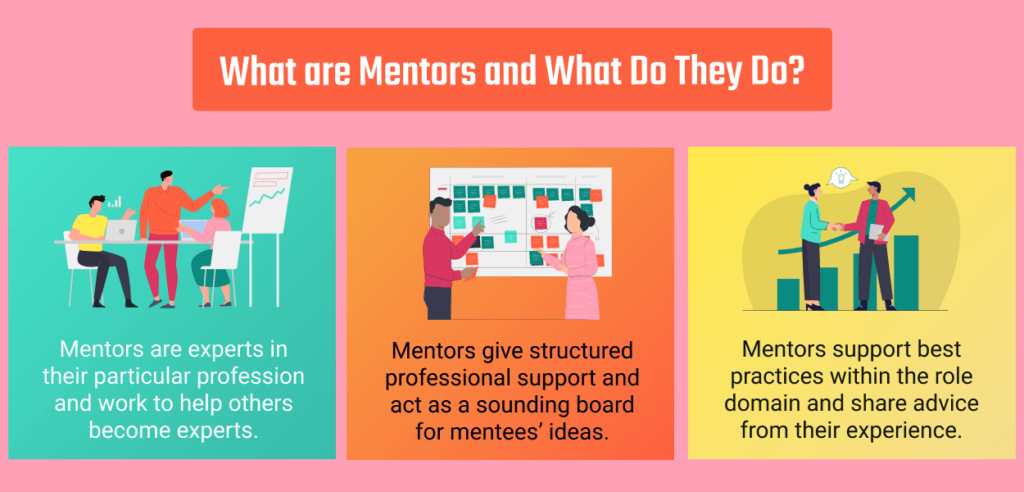In the past, mentoring programs in the workplace were usually only offered to upper management. The assumption was that the productivity of the C-Suite is most important for the business. Good advice can be hard to come by when you’re sitting at the top. Without many internal peers to provide guidance, it makes sense why an organization would organize external mentoring for its senior leaders.
But times have changed. AI technologies can now support widespread external mentoring for professional development programs at the office. There is also a greater awareness of the value of talent development for employees under the C-Suite, as concepts like hierarchical leadership become less important. HR departments finally have the technical tools – and the wisdom – to make mentoring programs available beyond the top executives.
What Does a Mentor Do?
Mentor program goals are always essentially the same: to get the employee up to speed in a specific area of their current or future role. A mentor can be somebody who is part of the onboarding process, for example, in a job shadowing program. A mentor can also get involved after the employee’s first few days or weeks at a company to close skill gaps that rear their ugly heads. If somebody is part of a leadership development program, mentors are vital for getting him or her prepared to advance. Creative programs such as reverse mentoring can even be used to give mentors an idea of what it’s like on the production line so that they can come up with better, on-point solutions.

Related content: Infographic: Coaching Versus Mentoring – What’s the Difference?
The Advantages of External Mentorship Programs for All Levels
It’s Practical
Mentoring in the workplace works because it is similar to active learning. In a traditional workplace setup, new employees attend onboarding sessions that are more about the company and how it operates than about how they should do a specific job. The typical approach with new employees is to throw them into the deep end. Basically, practical knowledge is gained on the fly and over time. It is often up to the employee to take initiative and become an expert as soon as possible.
In contrast, mentors are a source of real-time information while they explain–live and in person–how to do a role well. Questions are realized and answered on the spot. The process as a whole allows skill gaps to be subsequently dealt with, rapidly and practically. It’s a small wonder that 70% of Fortune 500 companies use them.
It Increases Satisfaction
The support that an employee gets from mentoring also helps with the twin challenges of employee retention and engagement. With ‘lack of development opportunities’ being the number one reason for quitting, mentoring lets employees gain the skills they need to advance. In fact, a Wharton University study found that mentored workers gained promotions at a rate five times higher than those who received no mentoring.
It’s Great for HR
Bringing in an external mentor to work with existing talent can help fill gaps due to cutbacks and vacant positions that are hard to hire for. It’s especially useful if you don’t have relevant knowledge bases. You can also use this as a recruitment tactic. High-quality job seekers are attracted to an organization’s development opportunities.
Mentoring Programs Best Practices
There are several ways to ensure that mentoring programs are as effective as possible:
Before…
Establish clear goals: Is mentoring for the purpose of onboarding, organizational development, or building leadership skills? This will affect who is being mentored and for how long. It’s also important to create a measurement system that lets you know if the program is succeeding.
Think outside the box: Remember that 1:1 programs aren’t the only way to do it. You can try other mentoring setups, such as reverse mentoring, internal mentoring, group sessions, and situational learning. Each can be adjusted to fit your budget, scheduling, and goals.
Recruit the right mentors: The goals of the program will affect what type of mentor is hired. They should have direct experience in the job for which the employee is being mentored, and be familiar with teaching according to the setup of the program.
…During…
Make a good match: Both mentors and employees should have a chance to say ‘no’ if they feel that the teacher-student chemistry isn’t happening. Make sure you have meet and greet sessions so that the two sides can get to know each other and find the best fit.
Encourage questions: Some employees might be reluctant to ask questions, and even the best mentors don’t explain everything. Mentors and HR staff should invite employees to pose questions about the job itself and the mentoring process.
…And After
Evaluate and assess feedback: Once the mentoring program has ended, take the time to interview everyone involved and get their impressions to improve the program. After a few weeks, go back to the participants and check if the program resulted in any benefits.
Create L&D programs: The mentoring process might discover that the employee needs some skill enhancement. Once the mentoring is over, leverage that to build a personalized learning initiative.
Expand: External mentoring programs yield many advantages–but they can only be enjoyed if HR expands the concept to other goals and employee levels. Of course, the lessons learned from feedback and evaluation should be applied to future initiatives.
Successful Mentorship Programs in the Real World
Mentoring is a tried and true practice used by major companies around the world, and with proven success. Here are just a few examples of major corporations that have deployed mentoring programs at every level of their organization.
Boeing
Boeing is one of the world’s largest aerospace companies, with more than a century of experience and market leadership. Boeing’s career and leadership mentoring program is a multi-level initiative that includes diverse activities. Their rotational program matches new employees with senior managers who provide advice regarding career planning; the 1-to-1 Learning Program is a peer mentoring system that focuses on skill development; and the Boeing Leadership Center enables high potential candidates to partner with current leaders, with an emphasis on interpersonal skills.
The company sees the importance of mentorship as a major reason that it was voted one of the “World’s Most Admired Companies” by Fortune Magazine.
McGraw-Hill Publishing
Since 1888, McGraw-Hill has been publishing educational material, and today is dedicated to ensuring that it competes in the digital world. To boost productivity, McGraw-Hill has a mentorship program for leadership development that it offers to 20,000 employees. The company studied best practices and partnered with a consulting group to define the program. It also uses frequent research to examine how successful the programs are. As almost all participants stated that they recommend the program, it’s clear McGraw-Hill employees are getting the help and development they need.
Novartis
Novartis is one of the largest pharmaceutical companies in the world, with more than 100,000 employees. In such a complex organization, it can be challenging for any single employee to understand how the organization functions and find the support they need. To resolve this issue, Novartis created an internal mentoring program that focuses on cross-functional and cross-country connections, with 75% of mentoring engagements being cross-functional. The usual arrangement is for employees in separate departments and countries to work together on relevant projects.
The company has seen remarkable success with its mentorship programs; some of its accolades include winning the “BEST” award in 2020 from the Association of Talent Development and the “Excellence in Partnership” honor at the 2019 Chief Learning Officer awards.
Caterpillar
Caterpillar leads the world in the manufacture of mining and construction equipment. As part of an initiative for continuous employee growth, the company created a variety of mentorship programs. Each new employee receives a mentor for a three-year partnership. Mentors cover a number of productivity topics with employees, such as soft skill development, work-life balance, and corporate policies.
Even after the three-year engagement is over, any employee can choose to work in different departments so as to become familiar with new functions and network within the company. Caterpillar also provides many group mentoring resources for the promotion of talent development. Also of note, the company hosts a reverse mentoring program where younger employees discuss recent technology developments and inter-generational relationships with senior managers.
Elsevier
Elsevier is a major player in the healthcare information and analytics industry. To support their global employee network in career management, Elsevier’s NetWorx mentorship program promotes leadership development and also uses reverse mentoring to influence corporate culture. Employees at any level can enroll in NetWorx, both as a student and as a mentor. Elsevier’s program includes setups beyond one-on-one relationships, with the centerpiece of NetWorx being a half-year mentoring engagement.
FAQs
What do you hope to gain from a mentoring program?
Mentoring programs help employees learn about new roles, and get better at the jobs that they are already doing. Unlike classroom or app-based learning, mentors physically demonstrate how the job works, provide personalized explanations, and answer whatever questions occur to the employee on the spot.
Why do companies develop formal mentoring programs?
A formal mentoring program gets official treatment, meaning that they are properly organized and backed by resources. In comparison, an informal mentoring program might suffer because there is no clear mandate from the company. Like any business initiative, measuring success is important, and a formal mentoring program will be analyzed so that HR can continuously improve it.
Why would you establish a mentoring program for your employees?
To prepare employees for new roles, they should understand what’s expected of them, what they can expect, and how to deal with any shortcomings. Employees can minimize the confusion and mistakes related to new situations by letting them see a mentor in action. Mentoring also helps to identify skill gaps so that L&D programs can build those skills.
How do I set up a mentoring program?
Like many L&D programs, mentoring requires the approval and support of senior management; promotion to employees; and a way of finding mentors who will help HR meet their goals. Internal mentorship programs, like what Boeing and Caterpiller do, can be highly beneficial – and cost-effective. External mentors in particular can be tough to locate because they need to have experience in exactly the field where employees require instruction – and either be close to the company HQ or offer virtual mentoring.
As noted above, professional development platforms are an essential tool for implementing these programs and can match employees with precisely the right experts.
Mentoring at Scale with GrowthSpace
The challenge of finding external mentors for specific job functions gets even more difficult in large organizations. GrowthSpace’s talent development solution is the leading choice for companies looking to implement personalized, multi-level mentorship programs at scale. GrowthSpace’s technology is fine-tuned to match granular employee training requirements with one of our thousands of vetted and highly sought-after mentors, coaches, and trainers around the globe.




